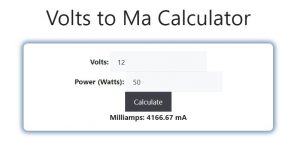About Volts to Ma Calculator (Formula)
The Volts to mA Calculator is a practical tool used in electrical engineering and electronics to convert voltage measurements into milliamperes (mA). Understanding the relationship between volts and milliamps is crucial for anyone working with electrical circuits, as it allows for the determination of current flow based on the applied voltage and the power consumed by the circuit. This calculator simplifies the conversion process, enabling users to ensure their circuits operate safely and efficiently.
Formula
The formula to convert volts to milliamps is:
Milliamps = Power / Volts * 1000
Where:
- Milliamps is the current in milliamperes.
- Power is the total power in watts.
- Volts is the voltage in volts.
How to Use
To use the Volts to mA Calculator, follow these steps:
- Determine Power: Identify the power consumed by the circuit in watts (W). This information can often be found on the device or equipment you are working with.
- Measure Voltage: Find the voltage being applied to the circuit in volts (V).
- Input Values: Enter the values for power and voltage into the calculator.
- Calculate Milliamps: Click the calculate button to obtain the current in milliamps (mA). This result will help you understand the current flowing through your circuit.
Example
Let’s illustrate how to use the Volts to mA Calculator with an example:
- Power: 50 watts
- Voltage: 12 volts
Using the formula:
Milliamps = Power / Volts * 1000
Milliamps = 50 / 12 * 1000
Milliamps ≈ 4166.67 mA
In this example, the circuit would draw approximately 4166.67 milliamps when powered by 12 volts at 50 watts.

FAQs
- What is the difference between volts and milliamps?
Volts measure electrical potential, while milliamps measure the flow of electrical current. - Why do I need to convert volts to milliamps?
Converting volts to milliamps helps determine the current flowing in a circuit, which is essential for ensuring safety and efficiency. - Is the Volts to mA Calculator accurate?
Yes, as long as the input values for power and voltage are accurate, the calculator will provide precise conversions. - Can I use this calculator for AC circuits?
Yes, the calculator can be used for both AC and DC circuits, but ensure you consider the power factor for AC calculations. - What happens if I enter a zero voltage?
Entering a zero voltage will result in an undefined or infinite current value, as current cannot be calculated with zero voltage. - What unit of power should I use?
Power should be entered in watts (W) for the calculation to be accurate. - Can this calculator help with designing circuits?
Yes, understanding the current flow is crucial for designing circuits safely and efficiently. - What is the maximum current limit for common circuits?
It varies by application, but common circuits may have limits ranging from a few milliamps to several amperes, depending on components. - How can I measure voltage and power in my circuit?
Voltage can be measured using a multimeter, and power can be calculated using the formula: Power = Voltage * Current. - Does the calculator account for resistance?
The calculator assumes a direct relationship between power and current; resistance is indirectly considered through Ohm’s Law. - What is the significance of using milliamps instead of amps?
Milliamps are often used for smaller devices and circuits, providing a more precise measurement for low current applications. - What is a common application for this calculation?
It is frequently used in powering LED circuits, small electronics, and battery-powered devices. - Can I convert milliamps back to volts?
Yes, you can rearrange the formula to find volts if you have the power and current values. - How do I handle high current applications safely?
Always ensure components are rated for the expected current and follow electrical safety protocols. - What tools do I need for these measurements?
A multimeter is essential for measuring voltage, current, and resistance in circuits. - Is this calculation affected by temperature?
Yes, temperature can affect the resistance of materials and the performance of electrical components, which may impact current flow. - How do I interpret the results of the calculator?
A higher mA result indicates greater current flow, which can help you assess the load and safety of your circuit. - What should I do if my calculated current exceeds component ratings?
You may need to redesign the circuit or use components that can handle the higher current. - Are there any limitations to this calculator?
The calculator assumes ideal conditions; real-world factors like resistance and efficiency should also be considered. - Can I save the results for future reference?
Many online calculators allow you to copy the results, or you can write them down for your records.
Conclusion
The Volts to mA Calculator is an invaluable resource for anyone working with electrical circuits, providing a straightforward method to convert voltage into current measurements. Understanding this relationship is essential for ensuring that devices operate safely and efficiently, helping you design and maintain effective electrical systems. Regular use of this calculator can enhance your proficiency in electrical work, allowing you to manage power consumption and circuit design more effectively.
